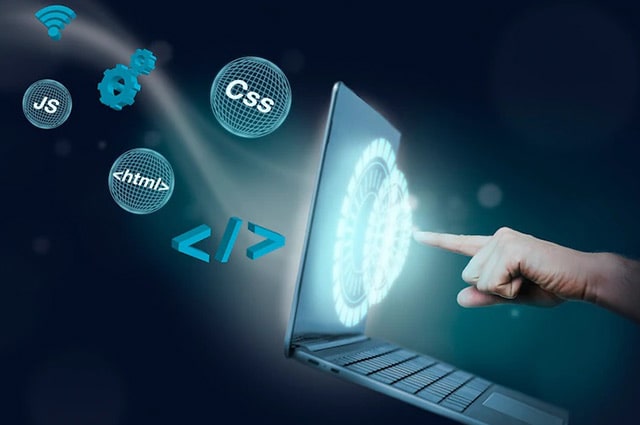Computer science is like learning the basics of how computers work and how to solve tricky problems with them. People who study computer science often work on cool stuff like new technology, teaching, or building big software systems.
On the flip side, full-stack developers are like the superheroes of websites. They know how to make the part you see and click on (called the frontend) look nice and work smoothly. They also know how to build the behind-the-scenes stuff (called the backend) that makes websites do all their cool tricks. So, full-stack developers can handle everything from making the buttons pretty to making sure the website’s databases run smoothly.
What is Computer Science and its Scope?

Computer Science is the study of computers and computational systems. It involves understanding both the theoretical and practical aspects of how computers work, how to design and develop software and hardware systems, and how to use computing technology to solve real-world problems.
Algorithms and Data Structures
Algorithms are step-by-step procedures or sets of rules for solving computational problems.
They can range from simple sorting algorithms like bubble sort to complex optimization algorithms like genetic algorithms or machine learning algorithms.
Analyzing algorithm efficiency involves studying their time complexity (how long they take to run) and space complexity (how much memory they use).
Data Structures
Data structures are ways of organizing and storing data in a computer so that it can be accessed and modified efficiently. Common data structures include arrays, linked lists, stacks, queues, trees, and graphs. Choosing the right data structure can significantly impact the performance of algorithms.
Programming Languages
Programming languages are often categorized into different paradigms, such as imperative, functional, object-oriented, and declarative. Each paradigm has its own set of principles and approaches to problem-solving.
Language designers create new programming languages or extend existing ones to better suit specific application domains or to address shortcomings in current languages.
Compilers translate source code written in a high-level programming language into machine code that can be executed by a computer, while interpreters execute source code directly without prior compilation.
Artificial Intelligence (AI) and Machine Learning
Neural networks are computational models inspired by the structure and function of the human brain. They consist of interconnected nodes (neurons) organized in layers and are used for tasks such as image recognition, natural language processing, and predictive modeling.
Deep learning is a subset of machine learning that uses neural networks with many layers (hence the term “deep”) to automatically learn features from data. It has achieved remarkable success in various domains, including computer vision, speech recognition, and autonomous driving.
Reinforcement learning is a type of machine learning where an agent learns to make decisions by interacting with an environment and receiving feedback in the form of rewards or punishments. It has applications in robotics, gaming, and autonomous systems.
Computer Vision and Image Processing
Image processing techniques include operations such as blurring, sharpening, edge detection, and noise reduction to improve image quality or extract useful information.
Computer vision algorithms can identify and classify objects within images or videos, enabling applications like object tracking, facial recognition, and augmented reality.
Computer vision techniques can reconstruct three-dimensional models of objects or scenes from multiple images, which is used in fields such as robotics, archaeology, and virtual reality.
Database Systems
Relational databases store data in tables with rows and columns, and they use structured query language (SQL) for data manipulation and retrieval. Examples include MySQL, PostgreSQL, and Oracle Database.
NoSQL databases use non-relational data models and are designed for scalability, flexibility, and performance in handling large volumes of unstructured or semi-structured data. Examples include MongoDB, Cassandra, and Redis.
Distributed databases distribute data across multiple nodes in a network, providing fault tolerance, scalability, and high availability. They are commonly used in cloud computing and big data analytics.
Software Engineering
The software development lifecycle (SDLC) encompasses phases such as requirements gathering, design, implementation, testing, deployment, and maintenance.
Software testing involves verifying that a software system meets specified requirements and behaves as expected under various conditions. It includes techniques like unit testing, integration testing, system testing, and acceptance testing.
Software architecture defines the structure and organization of software components, determining how they interact and communicate to fulfill system requirements. It involves decisions about design patterns, architectural styles, and scalability.
Operating Systems
An operating system manages processes, which are instances of executing programs. This includes process scheduling, synchronization, and communication.
Operating systems allocate and manage memory resources for running processes, ensuring efficient memory usage and preventing memory leaks or conflicts.
Operating systems provide file systems for organizing and storing data on storage devices such as hard drives and solid-state drives. They handle file operations like creation, deletion, reading, and writing.
Networking
Network protocols define rules and conventions for communication between devices in a network. Examples include TCP/IP, HTTP, SMTP, and FTP.
Network security mechanisms protect networks and the data transmitted over them from unauthorized access, interception, modification, and denial of service attacks. This includes encryption, authentication, firewalls, and intrusion detection systems.
Cybersecurity
Cybersecurity professionals analyze potential threats and vulnerabilities in computer systems and networks to identify security risks and develop mitigation strategies.
Security policies define rules and procedures for protecting information assets and regulating user behavior within an organization. They cover areas such as access control, data encryption, and incident response.
Ethical hackers use the same techniques as malicious hackers to identify security weaknesses in systems and networks, but with the permission of the system owners. This helps organizations improve their security posture and defend against real attacks.
Human-Computer Interaction (HCI)
HCI researchers design user interfaces that are intuitive, efficient, and enjoyable to use. This involves understanding user needs, preferences, and cognitive processes.
Usability testing involves observing users as they interact with a system to identify usability issues and gather feedback for iterative design improvements.
HCI encompasses designing systems that are accessible to users with disabilities, ensuring equal access to information and functionality for all users.
How to Become a Full Stack Developer?

Becoming a full stack developer involves gaining proficiency in both front-end and back-end development technologies, as well as understanding how to work with databases and deploy applications. Here’s a step-by-step guide to becoming a full stack developer:
Learn the Basics of Web Development
Start by learning HTML, CSS, and JavaScript, which form the foundation of web development. HTML is used for creating the structure of web pages, CSS is used for styling and layout, and JavaScript is used for interactivity and dynamic behavior.
Master Front-End Development
Dive deeper into front-end technologies by learning popular frameworks and libraries such as:
- React.js: A JavaScript library for building user interfaces, commonly used for building single-page applications (SPAs).
- Angular: A TypeScript-based framework for building client-side web applications, developed and maintained by Google.
- Vue.js: A progressive JavaScript framework for building interactive web interfaces, known for its simplicity and flexibility.
Learn Back-End Development
Gain proficiency in server-side programming languages and frameworks such as:
- Node.js: A JavaScript runtime built on Chrome’s V8 JavaScript engine, commonly used for building scalable and high-performance server-side applications.
- Express.js: A minimalist web framework for Node.js, often used for building RESTful APIs and server-side web applications.
- Django: A high-level Python web framework that enables rapid development and clean, pragmatic design, suitable for building robust web applications.
- Ruby on Rails: A popular web application framework written in Ruby, known for its convention over configuration approach and developer-friendly features.
Learn Database Management
Understand the fundamentals of database management systems (DBMS) and learn how to work with relational databases such as MySQL, PostgreSQL, or SQLite, as well as NoSQL databases like MongoDB or Firebase.
Learn how to write SQL queries for data manipulation, retrieval, and management. Explore database design principles, normalization, indexing, and optimization techniques.
Understand HTTP and RESTful APIs
Learn about Hypertext Transfer Protocol (HTTP) and how it works in the context of web development. Understand the principles of Representational State Transfer (REST) and how to design, implement, and consume RESTful APIs for communication between the front-end and back-end of web applications.
Version Control Systems
Familiarize yourself with version control systems like Git and platforms like GitHub or GitLab for managing and collaborating on code repositories. Learn basic Git commands for branching, committing, merging, and resolving conflicts.
Practice Building Full Stack Projects
Apply your knowledge by building full stack projects that integrate front-end, back-end, and database components. Start with simple projects and gradually increase complexity as you gain confidence and proficiency.
Experiment with different technologies, frameworks, and tools to broaden your skill set and deepen your understanding of full stack development.
Stay Updated and Continuously Learn
Keep up with the latest trends, technologies, and best practices in full stack development by reading blogs, watching tutorials, attending webinars, and participating in online communities and forums.
Continuously seek opportunities to expand your knowledge and skill set through self-study, online courses, workshops, and real-world projects.
Build a Portfolio and Network
Create a portfolio showcasing your full stack projects, including descriptions, code samples, and links to live demos or repositories.
Network with other developers, join online communities, participate in hackathons or coding competitions, and contribute to open source projects to build your reputation and connections in the developer community.
Seek Employment or Freelance Opportunities
Start applying for full stack developer roles at companies that align with your career goals and interests. Highlight your skills, experience, and portfolio in your resume and cover letter.
Consider freelance or contract work to gain practical experience, build your portfolio, and expand your professional network.
Comparing Computer Science vs Full Stack Development

Computer Science and Full Stack Development are related fields within the realm of technology, but they have distinct focuses and areas of expertise. Here are the key differences between Computer Science and Full Stack Development:
Focus and Scope
Computer Science is a broad academic discipline that encompasses the study of algorithms, data structures, programming languages, software engineering principles, theoretical foundations of computation, artificial intelligence, computer graphics, networking, databases, and more. It emphasizes both theoretical concepts and practical applications, with a focus on understanding the fundamental principles underlying computing systems.
Full Stack Development, on the other hand, is a specialized field within software development that focuses on building end-to-end web applications. It involves proficiency in both front-end (client-side) and back-end (server-side) technologies, as well as database management and deployment strategies. Full stack developers are responsible for designing, implementing, and maintaining all aspects of a web application, from the user interface to the server infrastructure.
Knowledge and Skills
Computer Science education typically covers a wide range of topics, including algorithms, data structures, programming languages, operating systems, computer architecture, software engineering, databases, networking, artificial intelligence, and more. Students learn theoretical concepts, problem-solving skills, and analytical thinking, which are applicable across various domains and technologies.
Full Stack Developers require a combination of front-end and back-end development skills, as well as knowledge of database management and deployment tools. They need to be proficient in HTML, CSS, JavaScript, and front-end frameworks like React, Angular, or Vue.js for building user interfaces.
On the back end, they need to know server-side programming languages like JavaScript (with Node.js), Python (with Django), or Ruby (with Ruby on Rails), along with database technologies like SQL or NoSQL databases. Additionally, they need to understand concepts like HTTP, RESTful APIs, version control, and deployment platforms.
Career Paths
Computer Science: A degree in Computer Science can lead to various career paths, including software development, systems programming, data science, machine learning, cybersecurity, network administration, research, academia, and more.
Computer scientists often work in industries such as technology, finance, healthcare, government, and academia, where they apply their knowledge and skills to solve complex problems and innovate new technologies.
Full Stack Developers typically specialize in building web applications and often work in software development companies, startups, digital agencies, or as freelancers. They may also pursue roles like front-end developer, back-end developer, web developer, or software engineer. With experience, full stack developers may advance to roles like technical lead, software architect, or project manager.
Depth vs Breadth
Computer Science education provides a deep understanding of foundational concepts and theoretical principles that underpin computing systems. It emphasizes critical thinking, problem-solving, and abstraction, enabling graduates to adapt to new technologies and domains throughout their careers.
Full Stack Development focuses on practical skills and hands-on experience in building web applications using specific technologies and frameworks. While full stack developers may have a strong foundation in web development, they may not necessarily possess the same depth of knowledge in theoretical computer science concepts as computer science graduates.
Final Words
So, we talked about computer science and full stack development. Computer science is about understanding how computers work, while full stack development is more about building websites and apps. If you’re curious about how things work and love solving problems, computer science might be for you.
But if you enjoy building things online and making them look good, full stack development could be your thing. Think about what you like doing and what you want to learn more about. Both computer science and full stack development can lead to cool jobs in technology!
